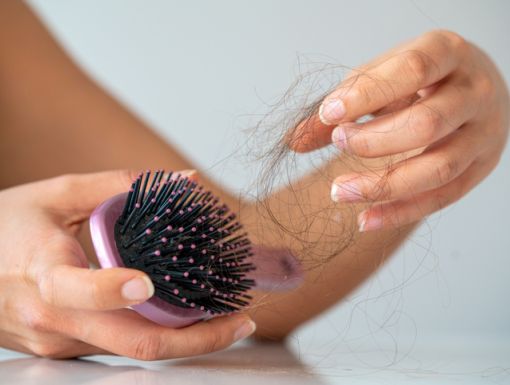
What Causes Balding in Men?
Hair loss, whether in women or men, can be devastating, affecting one’s confidence and self image. While there are many causes of hair loss, one of the most common causes is androgenetic alopecia. Men, in particular, are prone to this type of hair loss, also known as male pattern baldness. Roughly two-thirds of men face some degree of hereditary hair loss once they reach their 50s and 60s.
Androgenetic alopecia accounts for more than 90% of hair loss in men. Other factors, such as stress, certain medical treatments and diseases can also cause hair to fall out.
What does male pattern hair loss look like?
It is normal for people to shed between 100-150 strands of hair a day. For those with full heads of hair, this loss isn’t noticeable because new hair is growing in at the same time. By the time hair loss is recognized, roughly more than 50% of hair has been lost.
In male pattern hair loss, most men will first experience a receding hairline. Later,, they will notice thinning of hair on the crown of the scalp and the temple area.
What causes androgenetic alopecia?
Each hair grows from a tiny cavity in the scalp called a follicle. The follicle anchors each strand of hair to the skin. Balding begins to occur when the hair follicle shrinks over time, due in part to hormonal changes and heredity factors. Eventually, the follicle is reduced to the point where it stops growing hair.
Most men who experience male pattern baldness have inherited genes that cause the shrinking of the hair follicles, a process that can begin in the teenage years but more typically later in life.
Genetic factors play a major role in the likelihood of male-pattern baldness. Men who experience this type of hair loss may notice that many of their male relatives are bald. Folk wisdom has it that baldness comes from the mother’s side of the family, but recent studies indicate that the genetic component is more complicated. Researchers now believe genes that dictate hair loss are inherited from both sides of the family. Of course, there is not much you can do about which genes you inherit.
What are treatment options for androgenetic alopecia?
There are several treatments that are FDA approved to help with male pattern hair loss:
Topical minoxidil
Minoxidil, now available over the counter, was the first drug approved by the FDA for the treatment of male pattern baldness. It was widely used for many years to treat high blood pressure. Researchers eventually discovered that it promoted hair growth. In clinical trials, minoxidil used as a topical treatment has been shown to reduce hair loss, stimulate hair growth, and strengthen existing strands of hair. However, it is unlikely to promote full regrowth.
Finasteride
Finasteride is a prescription medication that is taken daily in pill form over a long period of time. Approved for use in 1992, it has been shown to slow down further hair loss in about 80% to 90% of men taking it. Finasteride can cause decreased libido and can rarely cause infertility.
Hair transplantation
Major strides have been made in hair transplant procedures. In the 1970s, doctors installed hair plugs in thinning areas of the scalp. In time, the plugs became very noticeable. Today, hair transplantation has advanced to help people achieve natural looking results. The major downsides to this procedure are cost and time.
Platelet-rich plasma
New studies have suggested the utility of using platelet rich plasma as a possible treatment option for male pattern hair loss. While this is not a permanent solution, PRP can be used alone or given before a hair transplant to improve and maintain results. PRP is obtained by using the individual’s own blood so the likelihood of developing any reactions is few to none. The downside to this procedure is cost as this is typically not covered by medical insurance and treatments would need to be repeated for continued results.
It should be noted that the best results are seen when treatment is started as soon as hair loss is noticed. Also important to understand is that once any of these treatments is stopped, the condition will revert back to its original state. For these reasons, it is important to discuss with your dermatologist regarding the best treatment plan for you.
Learn more about dermatologist Jessica Chu, MD



